Annotation.
The article is devoted toanalysis of the calculation of losses in a two-winding power transformer... The authors also suggestpractical implementation of the method for calculating transformer losses inMSExcel.
Keywords:
power two-winding transformer, calculation of energy losses, method of average loads.
The transfer of electrical energy from the source to the final consumer is inevitably associated with the loss of part of the power and energy in the power supply system. With an increase in electricity tariffs, the economic significance of the problem of electricity losses increases, due to the inclusion of standard values of losses in the tariff, as well as a decrease in the profit of grid companies due to excess losses. It also makes it difficult to connect additional capacities to electric grids, and reducing electricity losses in electric grids is an effective means of increasing their throughput, which allows grid companies to expand the scope of services for consumers' access to grids. The regulatory framework for calculating electricity losses is the Instruction for organizing in the Ministry of Energy Russian Federation work on the calculation and substantiation of standards for technological losses of electricity during its transmission through power grids, approved by order of the Ministry of Energy of the Russian Federation dated 30.12.2008 No. 326 (registration of the Ministry of Justice of Russia reg. No. 13314 dated 12.02.2009).
Electricity losses in transformers are one of the types of technical electricity losses due to the peculiarities of the physical processes occurring during the transmission of energy. Consider the methodology for calculating electricity losses in a two-winding power transformer for a billing period (month, quarter, year).
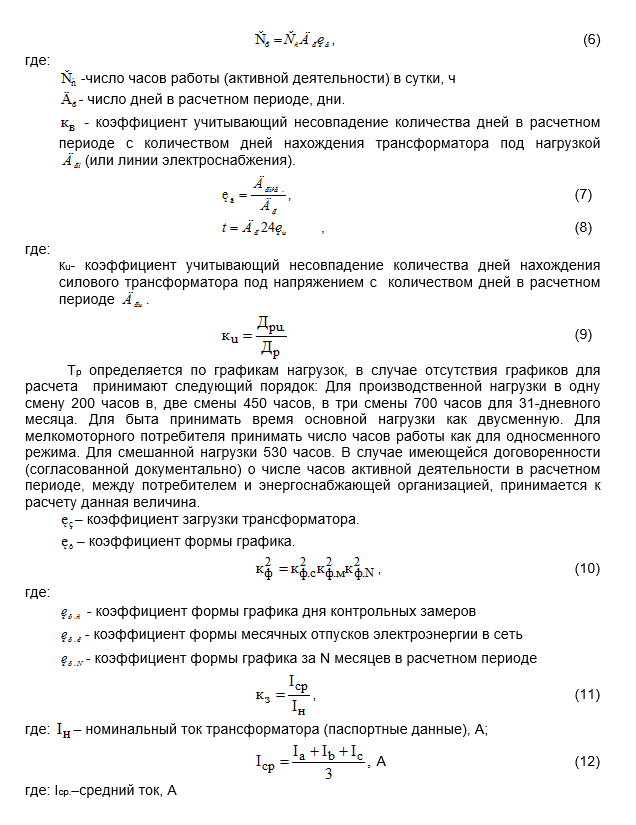
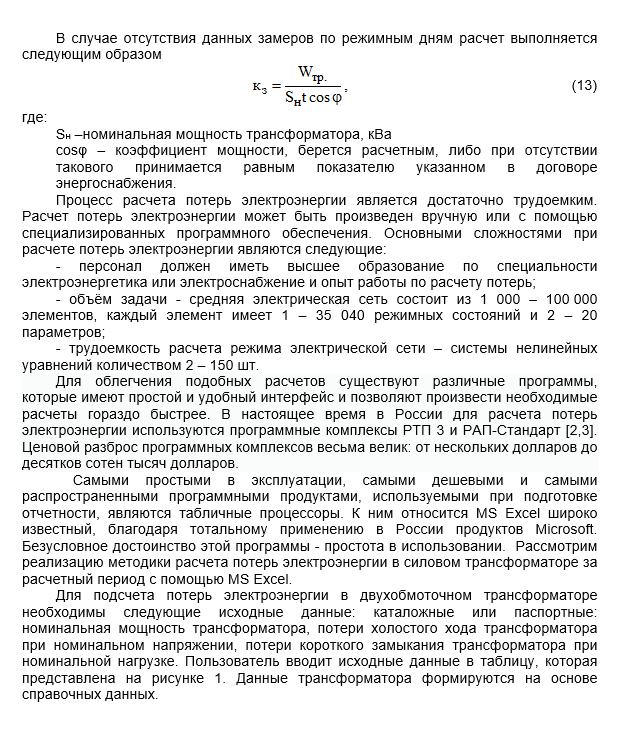
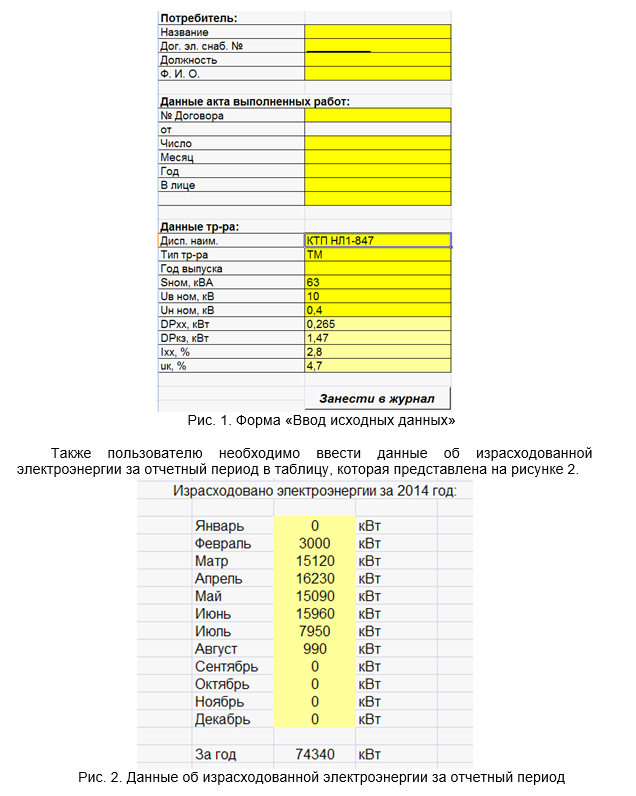
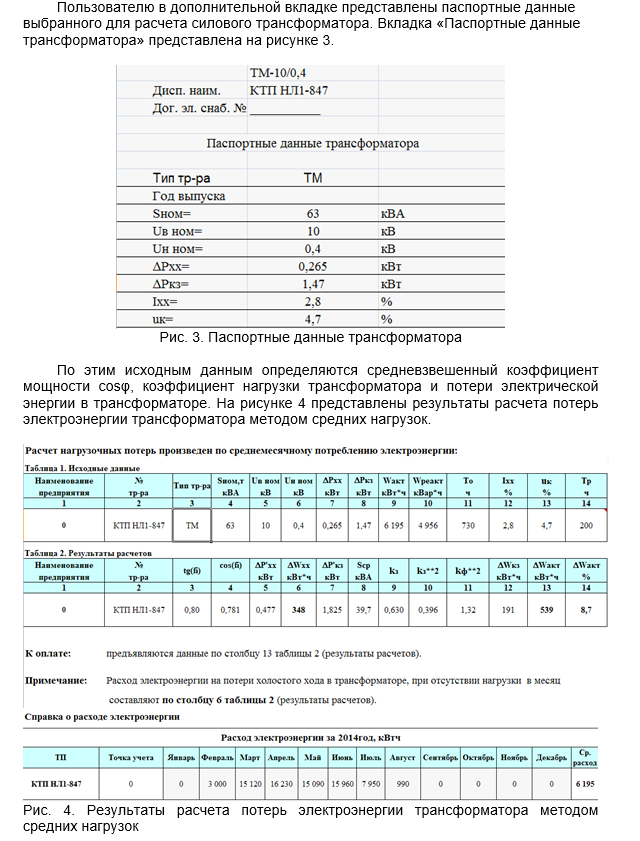
In Russia and abroad, several dozen software packages have been developed to solve various problems associated with calculating electricity losses. These complexes differ as a set of functional and service capabilities, cost, reliability and other parameters. But the use of MS Excel continues to be widely used by Russian power grid companies for calculating electricity losses, since it does not require special training of personnel and has a clear and intuitive interface.
- Yu.S. Zhelezko, A.V. Artemiev Calculation, analysis and regulation of electricity losses in electrical networks: a guide for practical calculations. -M .: Publishing house NTs ENAS, 2003.
- Guidelines for determining the losses of electrical energy in urban electrical networks with a voltage of 10 (6) -0.4 kV. (Developed by the Russian joint-stock company Roskommunenergo and ZAO ASU Mosoblelektro. Approved by the State Energy Supervision Service of the Ministry of Energy of Russia (09.11.00 # 32-01-07 / 45)).
- Vorotnitsky V.E., Kalinkina M.A. Calculation of regulation and reduction of electrical energy losses in electrical networks. Study guide. 2nd ed.-M .: IPKgosluzhby, 2001.
n1.doc
3.3. Power losses in transformers
In the reference literature, the values of the characteristics of the transformer at nominal load are given:? Р хх - active no-load losses, kW; ? R kz - losses short circuit, kW; I n - rated current, A; I xx - no-load current, A;S n - rated power of the transformer, kVA; U kz% - short-circuit voltage,%.
Accordingly, we obtain for the rated load of the transformer:
no-load jet loss
Reactive short circuit losses
 .
.
At a load different from the nominal ( 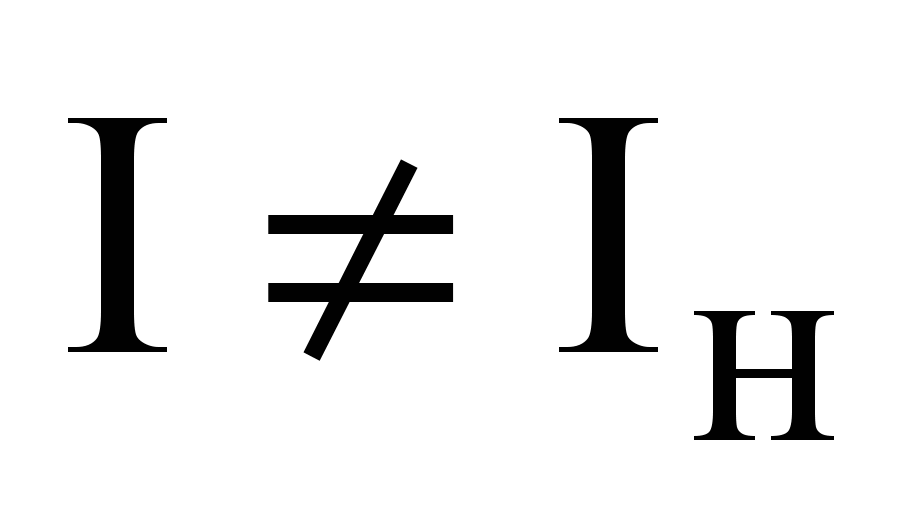 ):
):
active short-circuit losses are ![]() ;
;
reactive short-circuit losses  .
.
Total power losses in the transformer taking into account the load:
active
 ;
;
jet
 .
.
3.4. Operating modes and selection of the number and power of transformers
With an increase in the power of transformers, short-circuit currents increase. Therefore, the unit power of transformers supplying electrical installations up to 1000 V is limited by the permissible values of the short-circuit current. It is considered impractical to use transformers with secondary voltage up to 0.4 kV with a capacity of more than 2500 kVA. The number of standard sizes of transformers in the shop should be minimal.Single-transformer substations are recommended to be used if there are power receivers in the shop (building) that allow a power outage for the time of delivery of the "warehouse" reserve, or when redundancy is carried out on low voltage lines from neighboring transformer substations, that is, they are acceptable for consumers of III and II categories , as well as in the presence of a small number (up to 20%) of category I consumers in the 380 - 660 V network.
It is recommended to use two-transformer substations in the following cases: with the predominance of consumers of category I and the presence of consumers of a special group; for a concentrated shop load and stand-alone facilities for general plant purposes (compressor and pumping stations); for workshops with high specific load density (above 0.5 - 0.7 kVA / m 2).
When choosing the number and capacity of workshop transformers, the consumed load of the workshop and the specific load density n are taken into account. With a load density of up to n = 0.15 kVA / m 2, it is advisable to use transformers with a capacity of up to 1000 and 1600 kVA, with a density of 0.15 - 0.35 kVA / m 2 - with a power of 1600 kVA. With a density of more
0.35 kVA / m 2 the expediency of using transformers with a capacity of 1600 or 2500 kVA is justified by technical and economic calculations according to.
The approximate selection of the number and capacity of shop transformers is made according to the specific density n load
n = S p / F,
where S p is the estimated load of the shop (building, department), kVA; F - area of the shop (building, department), m 2.
It is recommended to select the rated power of transformers according to the rated power of normal and emergency modes of operation based on rational loading in normal mode and taking into account the minimum required redundancy in the post-emergency mode. The rated power of transformers S n.t is determined by the average load P s for the maximum loaded shift:
S n.t = P s / (N k s),
where N is the number of transformers; k s - load factor of the transformer.
Optimal loading of workshop transformers depends on the reliability category of electricity consumers, on the number of transformers and the method of redundancy. It is recommended to take the following load factors of transformers: for shops with a prevailing load of category I for two-transformer transformer substations k z = 0.75 - 0.8; for workshops with a predominant load of category II for single-transformer substations in the case of mutual redundancy of transformers at low voltage k z = 0.8 - 0.9; for workshops with a load of category III k z = 0.95 - 1.
When choosing the number and capacity of shop transformers, the issue of the economically feasible value of reactive power transmitted through transformers to the network with a voltage of up to 1 kV should be simultaneously resolved.
The optimal number of transformers and their capacity are found at the minimum of the reduced costs (thousand rubles):
 ,
,
where N is the number of transformers and switching devices;
E n - coefficient of efficiency of capital investments (E n = 0.12);
E ai - depreciation rate;
K i - the cost of the i-th transformer or switching device, thousand rubles;
C about - the cost of one kW. h of electricity;
W a - annual electricity losses (kWh) in one transformer;
n is the number of transformers.
where?  and?
and?  reduced power losses of no-load and short-circuit in the transformer, kW;
reduced power losses of no-load and short-circuit in the transformer, kW;
T about - the number of hours of connecting the transformer to the network during the year;
Tr is the annual number of hours of operation of the transformer under load;
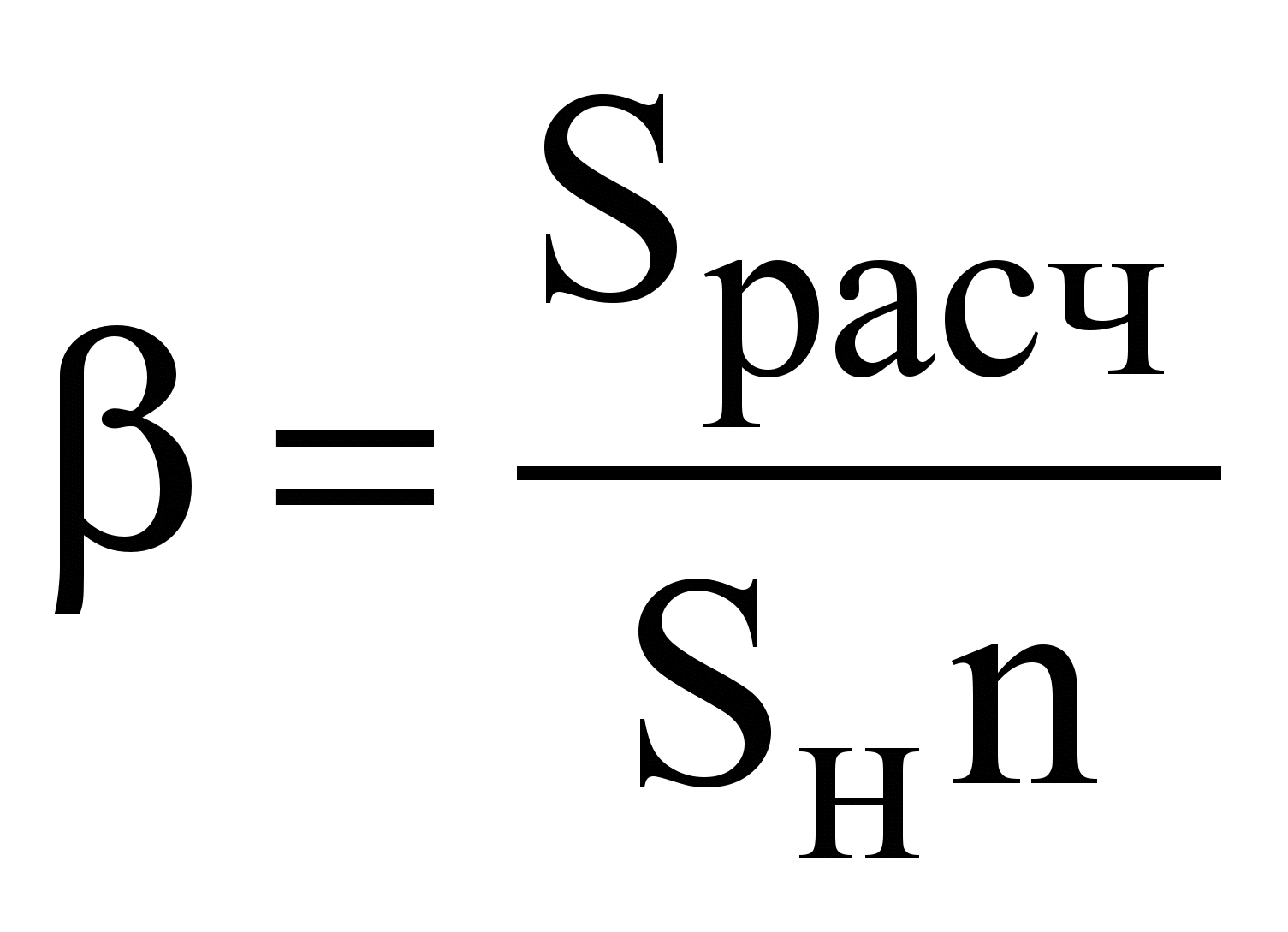 is the load factor of the transformer.
is the load factor of the transformer.
Reduced active no-load losses
 ,
,
where  .
.
Reduced active short-circuit losses
 , kW,
, kW,
where 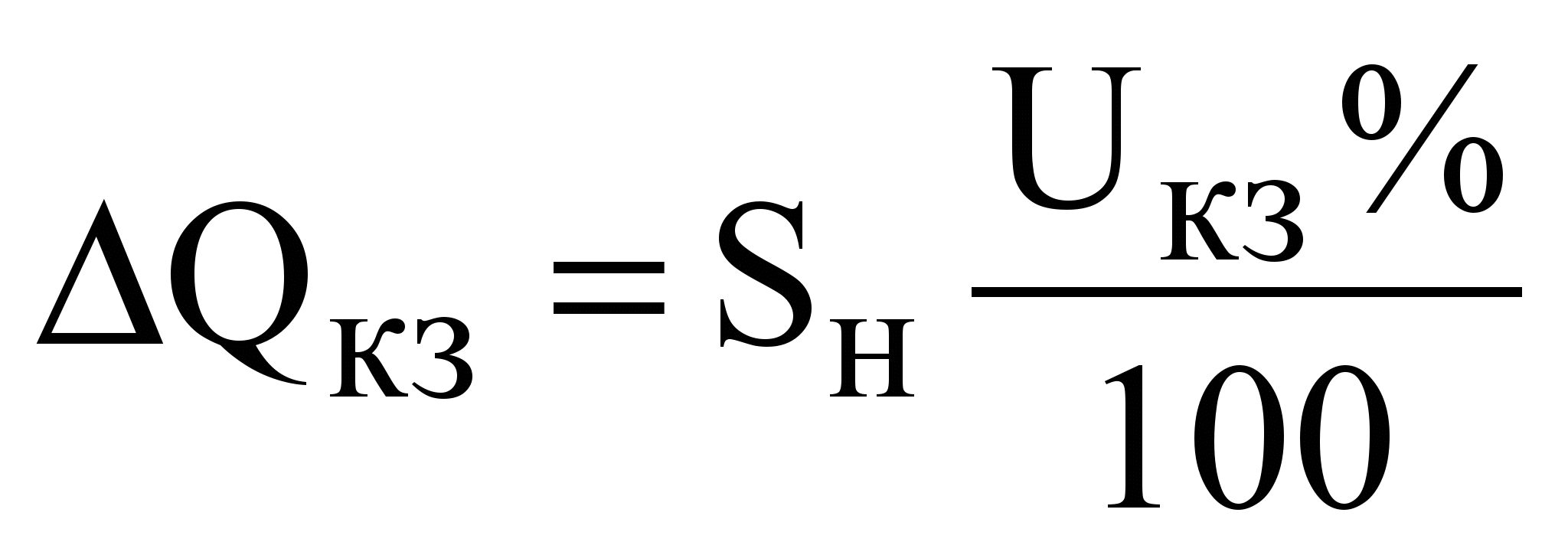 .
.
KPP is the coefficient of increase in active power losses due to the transfer of reactive power (see table).
Table *
| Characteristics of the transformer and power supply system | kp, kW / kvar |
|
| Transformers powered directly from substation busbars | ||
| Mains transformers powered by generator voltage power plants | ||
| Step-down transformers 110/35/10 kV, powered by district networks | ||
| Step-down transformers 6 - 10 / 0.4 kV, powered by district networks | ||
The obtained values of the reduced active losses of active power? and? substituted in the expression for? W a and then determine the reduced costs Z.
In simplified calculations, it is allowed to choose transformers according to the reduced active power losses in them:
 .
.
Choose the option with the smallest  .
.
Do they depend on the load factor? and the number of transformers (see fig. *).

Figure 3.1. Dependence of the reduced active power losses in transformers on their load and number
The value of the critical load factor? critical , at which it is necessary to switch to the operation of two transformers is determined from the expression:
 ,
,
where  .
.
3.5. Voltage losses in transformers and voltage regulation
In transformers, under the action of the load, a voltage loss occurs (see table 3.1).
Table 3.1
Voltage loss (%) in transformers at rated load (? = 1)
| Rated power transformer, kVA | Power factor (cos?) |
|||||
| 0,7 | 0,8 | 0,85 | 0,9 | 0,95 | 1,0 |
|
| 100 | 4,27 | 4,01 | 3,81 | 3,54 | 3,02 | 1,97 |
| 160 | 4,16 | 3,85 | 3,62 | 3,32 | 2,77 | 1,66 |
| 250 | 4,07 | 3,73 | 3,50 | 3,18 | 2,61 | 1,48 |
| 400 | 4,02 | 3,67 | 3,42 | 3,10 | 2,52 | 1,38 |
| 630 | 4,67 | 4,18 | 3,85 | 3,42 | 2,66 | 1,20 |
| 1000 | 4,68 | 4,19 | 3,86 | 3,44 | 2,67 | 1,22 |
| 1600 | 4,62 | 4,12 | 3,78 | 3,35 | 2,58 | 1,12 |
When the load of the transformer differs from the nominal, the voltage loss is determined by the formula:
U t% =? (U а% cos? +? U р% sin? )
where U a% is the active component of the voltage loss in the transformer U a% = 100P kz / S n.t,%;
U р% - reactive component of voltage loss in the transformer
 ,
,
where U kz% - short-circuit voltage,%; P kz - short-circuit power losses, kW; S n.t - rated power of the transformer, kVA; ? - the load factor of the transformer,? = I p / I n.t.
Example 8.2 For the TMZ-1000/10 / 0.4 transformer, determine the voltage loss under the load Pp = 575 kW at cos = 0.9. The solution is given in table. 3.2.
Table 3.2
Determination of the available voltage loss in the network
low voltage
| Calculated values and formulas | KTP number |
||
| KTP 2nd section | |||
| Rated load current  , A , A | 1097 | ||
| Rated current of the transformer  , A , A | 1443,4 | ||
| Transformer load factor? = I p / I n.t. | 0,76 | ||
| Options | P kz, kW | 10,8 | |
| transform- | S n.t, kVA | 1000 | |
| Torah | U cs%,% | 5,5 | |
| A loss stresses in the transformer | U a% = 100P kz / S n.t,%;
? U т% =? (U а% cos? +? U р% sin?) | 1,08 5,39 | |
In conditions normal work electrical receivers, voltage deviations at their terminals from the nominal value are allowed within the following limits:
5%… + 10% - at the terminals of electric motors and apparatus;
2.5%… + 5% - at the terminals of working lighting devices.
Accordingly, the permissible (available) value of the voltage loss in electrical network low voltage is:
for power networks
U with% = U 0% -? U t% - U min.dv%;
U with% = 105 -? U t% - 95% = 10% -? U t%.
for lighting networks
U with% = U 0% -? U t% - U min lamp%;
U with% = 105 -? U t% - 97.5% = 7.5% -? U t%,
where U 0% is the no-load voltage or the rated voltage of the secondary winding of the transformer in percent; ? U t% - voltage loss in the transformer; U min.dv% and U min.lamp% are the minimum allowable voltages, respectively, on the motors and on the lamps.
Due to the fact that the voltage at the terminals of power transformers depends on the load, to maintain the required voltage in the network, all power transformers with a capacity of more than 6300 kVA are equipped with voltage regulators. For all transformers of lower power, the rated voltage of the secondary windings is set 5% higher than the rated one.
7. Calculation of power losses in the transformer
Power losses in transformers consist of active and reactive power losses.
Losses of active power consist of two components: losses going to heating the transformer windings, depending on the load current and losses going to heating the steel, depending on the load current.
Reactive power losses consist of two components: losses caused by magnetic flux dissipation in the transformer, which depend on the square of the load current, and losses that go to the magnetization of the transformer, independent of the load current, which are determined by the no-load current.
Calculation of power losses in a transformer is necessary for a more accurate selection of high voltage networks, as well as for determining the cost of electricity.
Determine the active power losses in the transformer ΔP, kW, according to the formula
ΔP = P kz · K zn 2 + P xx,
where P kz - active power losses in the transformer during the short circuit experiment
Р хх - active power losses in the transformer during the idle run experiment, kW.
ΔP = 7.3 · 0.6 2 +2 = 4.6 kW.
We calculate the reactive power losses in the transformer ΔQ, kVar
ΔQ = 0.01 (U kz K zn 2 + I xx) S n,
where Uc.z. - voltage during the short-circuit test as a percentage of the nominal
Iх.х. - current at the experience of no-load as a percentage of the nominal
ΔQ = 0.01 (5.5 0.6 2 +3) 630 = 31.4 kvar.
Determine the total power loss in the transformer ΔS, kVA
ΔS = = 31.7 kVA.
All the data obtained are summarized in table 4.
Table 4 - Power losses in the transformer
| Transformer type | ΔP, kW | ΔQ, kVar | ΔS, kVA | |||
| TSZ-630/10 | 630 | 10 | 0,4 | 4,6 | 31,4 | 31,7 |
So, the power losses in the transformer will depend on the load factor of the transformer, on its design and full rated power. To reduce losses, it is necessary to choose the right transformer and load it optimally.
8. Calculation and selection of networks with voltage above 1 kV
The criterion for choosing the cross-section of cable lines is the minimum of the reduced costs. In the practice of designing lines for mass construction, the choice of a section is made not according to comparative technical and economic calculations in each specific case, but according to standardized generalized indicators.
Because networks with voltages above 1 kV are not included in the list, then the choice of networks to the workshop transformer substation is carried out according to the economic current density j eq,. We calculate the maximum active power passing through the high-voltage cable, P m (10), kW, taking into account the power losses in the transformer
P m (10) = P m c + n tr · ΔP,
P m (10) = 725.12 + 2.4.6 = 734.32 kW.
We determine the maximum reactive power passing through the cable U = 10 kV, taking into account the power losses in the transformer Q m (10), kVar, according to the formula
Q m (10) = Q m "+ n tr · ΔQ,
Q m (10) = 210.72 + 2 * 31.4 = 273.52 kvar.
Determine the total power in high voltage networks S m (10), kVA
S m (10) = ![]() = 783.6 kVA.
= 783.6 kVA.
We calculate the coefficients of active (cosφ (6)) and reactive (tgφ (6)) power of a high-voltage line
cosφ (10) = = 0.94,
tgφ (10) = = 0.37.
We calculate the current flowing through the line with voltage U = 10 kV I m (10), A
I m (10) = = 22.6 A.
According to the reference book, we determine the economic current density, taking into account that the number of hours of use of the maximum load per year T m = 3000-5000 thousand hours / year and the laid cable of the AAShv brand
j eq = 1.4 A / mm 2
Determine the economically feasible section of the cable F eq, mm 2
F ec = = 16.14 mm 2.
We accept the cable of the nearest standard cross-section 16 mm 2 for laying, i.e. ААШв 3х16 with permissible current I d, A, determined from the catalog
Determine the permissible current value, taking into account the correction factors
I d "= I d · K p · K t,
where K p - correction factor for parallel laying of two cables
in the trench, taken from the catalog according to, Kp = 0.9;
K t - correction factor for the ground temperature, taken from the catalog, Kt = 1, since adopted temperature t = 15 ºC.
I d "= 80 · 0.9 · 1 = 72 A> I m (10) = 22.6 A.
According to the reference book, we determine the active (r 0) and reactive (x 0) resistance of the cable line, Ohm / km
r 0 = 1.95 Ohm / km,
x 0 = 0.113 Ohm / km.
We check the selected cable for voltage loss ∆U,%, which according to should not exceed 5%
∆U = ![]() ,
,
∆U = ![]() =0,59% .
=0,59% .
We enter the cable parameters in table 5.
Table 5 - Cable parameters
| Brand and section of cable | l, km | ΔU,% | |||||
| 10 | 22,6 | ААШв 3 × 16 | 72 | 1,95 | 0,113 | 0,8 | 0,59 |
ААШв - cable with aluminum conductors, with paper insulation, aluminum sheath, in a PVC hose.
So, the cable selected according to the economic current density provides a decrease in cable resistance, the possibility of expanding production, as well as a current margin, which leads to a decrease in operating costs, since the cable heats up much less, thereby ensuring less physical wear of the insulation, and how the result is fewer damages and breakdowns.
A transformer is a device that is designed to convert the electrical power of the network. This installation has two or more windings. In the course of their work, transformers can convert the frequency and voltage of the current, as well as the number of phases in the network.
In the course of performing the specified functions, power losses in the transformer are observed. They affect the initial amount of electricity that the device produces at the output. What are losses and efficiency of a transformer will be discussed below.
Device
The transformer is a static device. It is powered by electricity. In this case, there are no moving parts in the structure. Therefore, an increase in electricity costs due to mechanical reasons is excluded.
With the operation of power equipment, electricity costs increase during non-working hours. This is due to an increase in active no-load losses in steel. At the same time, a decrease in the nominal load is observed with an increase in the reactive-type energy. The energy losses that are determined in the transformer are related to the active power. They appear in the magnetic drive, on the windings and other components of the unit.
Loss concept
When the unit is in operation, part of the power goes to the primary circuit. It dissipates in the system. Therefore, the power supplied to the load is determined at a lower level. The difference is the total power reduction in the transformer.
There are two types of reasons for which there is an increase in the energy consumption of equipment. They are influenced by various factors. They are divided into the following types:
- Magnetic.
- Electrical.
They should be understood in order to be able to reduce electrical losses in a power transformer.
Magnetic loss
In the first case, the losses in the steel of the magnetic drive consist of eddy currents and hysteresis. They are directly proportional to the mass of the core and its magnetic induction. The iron itself, from which the magnetic drive is made, affects this characteristic. Therefore, the core is made of electrical steel. The plates are made thin. There is an insulation layer between them.
Also, the frequency of the current affects the decrease in the power of the transformer device. As it rises, the magnetic losses also grow. This indicator is not affected by the change in device load.
Electrical losses
A decrease in power can be determined in the windings when they are heated by current. In networks, such costs account for 4-7% of the total amount of energy consumed. They depend on several factors. These include:
Power losses in transformers are variable. It is influenced by the square of the current in the circuits.
Calculation method
Transformer losses can be calculated using a specific method. This will require obtaining a number of initial characteristics of the transformer operation. The technique presented below is used for double-winding varieties. For measurements, you will need to obtain the following data:
- System power rating (Nm).
- Losses determined at no-load (XX) and rated load.
- Short circuit losses (SCL).
- The amount of energy consumed per a certain amount of time (PE).
- The total number of hours worked per month (quarter) (HR).
- The number of hours worked at the nominal load level (LF).
Having received this data, the power factor (angle cos φ) is measured. If the system does not have a reactive power meter, its tg φ compensation is taken into account. For this, the dielectric loss tangent is measured. This value is converted into a power factor.
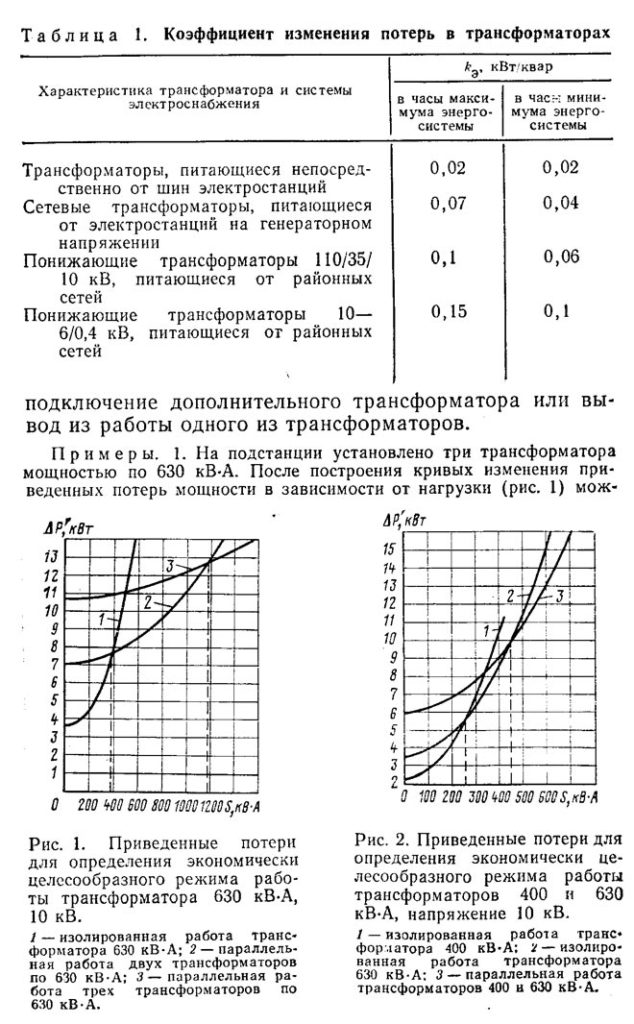
Calculation formula
The load factor in the presented method will be determined by the following formula:
K = Ea / NM * OCH * cos φ, where Ea is the amount of active electricity.
What losses occur in the transformer during the loading period can be calculated according to the established method. For this, the formula is applied:
P = XX * OCH * PKZ * K² * LF.

Calculation for three-winding transformers
The above technique is used to evaluate the performance of two-winding transformers. For equipment with three circuits, it is necessary to take into account a number of data. They are indicated by the manufacturer in the passport.
The calculation includes the rated power of each circuit, as well as their short-circuit losses. In this case, the calculation will be made according to the following formula:
E = ESN + ENN, where E is the actual amount of electricity that passed through all the circuits; ESN - electric power of the medium voltage circuit; ENN - low voltage electricity.

Calculation example
To make it easier to understand the presented methodology, you should consider the calculation for specific example... For example, you need to determine the increase in energy consumption in a 630 kVA power transformer. It is easier to present the initial data in the form of a table.
| Designation | Decryption | Meaning |
|---|---|---|
| NN | Rated voltage, kV | 6 |
| Ea | Active electricity consumed per month, kWh | 37106 |
| NM | Rated power, kVA | 630 |
| PKZ | Loss of short circuit of the transformer, kW | 7,6 |
| XX | No-load losses, kW | 1,31 |
| OCH | The number of hours worked under load, h | 720 |
| cos φ | Power factor | 0,9 |
Based on the data obtained, a calculation can be made. The measurement result will be as follows:
P = 0.38 kW * h
% loss is 0.001. Their total number is equal to 0.492%.
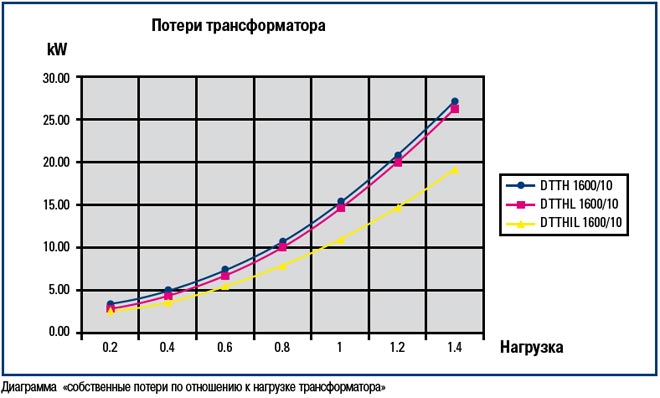
Measuring efficiency
When calculating losses, the efficiency is also determined. It shows the ratio of active type power at input and output. This indicator is calculated for a closed system according to the following formula:
Efficiency = M1 / M2, where M1 and M2 are the active power of the transformer, determined by measurements on the input and outgoing circuits.
The output value is calculated by multiplying the rated power of the installation by the power factor (cosine of the angle j squared). It is taken into account in the above formula.
In transformers 630 kVA, 1000 kVA and other powerful devices, the indicator can be 0.98 or even 0.99. It shows how efficiently the unit works. The higher the efficiency, the more economically energy is consumed. In this case, the cost of electricity during the operation of the equipment will be minimal.
Having considered the methodology for calculating the power loss of a transformer, short circuit and no-load, it is possible to determine the efficiency of the equipment, as well as its efficiency. The calculation method involves using a special calculator or making a calculation in a special computer program.

 , %
, %


